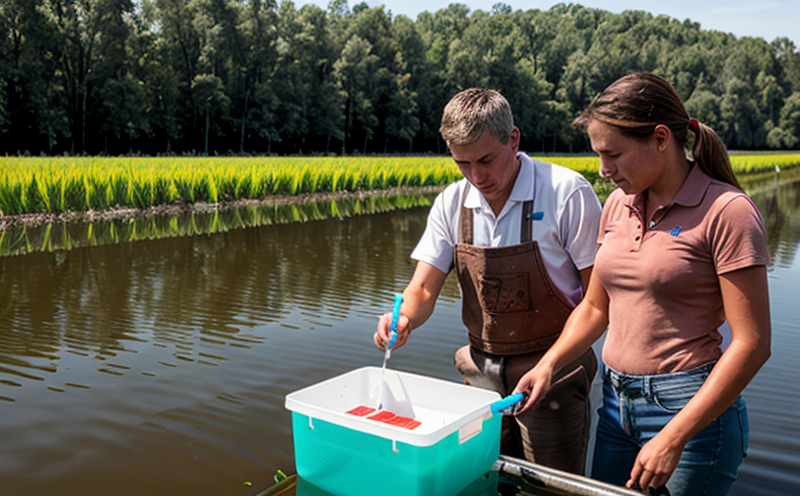Color Testing in Irrigation Water
In agriculture and forestry testing, water quality is a critical parameter that directly impacts crop health and yield. Among the various parameters tested, color testing in irrigation water plays an essential role in ensuring the quality of water used for agricultural purposes. This service involves the quantification of color intensity in water samples to assess their suitability for irrigation.
The color of water can be indicative of various factors including organic matter content, contamination from fertilizers or pesticides, and other pollutants. Understanding and managing these parameters are crucial for maintaining sustainable agricultural practices. The process begins with collecting representative water samples from different sources such as wells, reservoirs, or rivers used in irrigation systems.
The color is typically measured using a spectrophotometer that provides a numeric value known as the Hazen unit (HU). This measurement helps in quantifying the color intensity and assists in making informed decisions regarding water treatment and usage. Proper color testing ensures that only water meeting specific standards is used for irrigation, thereby minimizing potential harm to crops and the environment.
The primary objective of this service is to provide accurate and reliable data on water quality parameters, particularly focusing on color. This information is vital for agricultural stakeholders who rely on these tests to comply with local regulations and ensure water safety. The use of advanced instrumentation ensures precision and accuracy in measurements, which are essential for maintaining the integrity of irrigation systems.
Water samples are collected according to specified protocols that vary based on the type of irrigation system used. For instance, surface water sources may require different handling procedures compared to groundwater sources. Once collected, the samples undergo rigorous preparation processes before being analyzed using spectrophotometric methods. These methods involve diluting the samples and calibrating the instrument correctly to obtain accurate readings.
The importance of this service cannot be overstated in today’s world where sustainable agriculture practices are increasingly prioritized. By providing reliable color testing results, we contribute significantly towards ensuring that agricultural activities do not adversely affect water quality. This service supports regulatory compliance while also promoting environmental stewardship by identifying potential issues early on.
Understanding the nuances of color testing requires knowledge about various factors influencing it, such as light absorption characteristics and scattering effects. These aspects are crucial for interpreting results correctly and taking appropriate actions based on them.
Benefits
- Promotes Crop Health: Ensures that only water meeting specific quality standards is used for irrigation, thereby promoting healthy plant growth.
- Enhances Water Use Efficiency: By identifying and addressing issues early on through regular color testing, resources can be allocated more effectively.
- Supports Regulatory Compliance: Helps agricultural entities comply with local regulations regarding water quality standards.
- Maintains Environmental Sustainability: Identifies potential environmental impacts associated with irrigation practices and takes steps to mitigate them.
These benefits underscore the importance of this service in maintaining sustainable agricultural practices while ensuring optimal crop health and yield.
International Acceptance and Recognition
- ISO Standards: Color testing follows international standards such as ISO 10576, which provides guidelines for measuring color in water samples. Compliance with these standards ensures consistency across different regions.
- Agricultural Authorities: Many agricultural authorities worldwide recognize and mandate color testing as part of their quality assurance protocols for irrigation water.
The acceptance and recognition by international bodies and local authorities highlight the significance of this service in the broader context of sustainable agriculture practices globally.
Environmental and Sustainability Contributions
Efficient color testing contributes significantly to environmental sustainability efforts. By identifying and addressing issues related to water quality early on, agricultural stakeholders can prevent further contamination of natural water bodies. This proactive approach helps protect aquatic ecosystems from pollutants that might otherwise be introduced into them.
Moreover, the accurate identification of contaminants present in irrigation water allows for targeted interventions aimed at reducing their concentration levels. Such measures contribute positively towards preserving biodiversity within these ecosystems and maintaining ecosystem services.
The use of color testing aligns well with broader sustainability goals by fostering responsible resource management practices among agricultural communities worldwide. It encourages sustainable development initiatives that balance economic growth with environmental protection.





